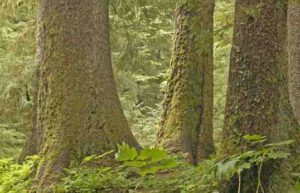Documents obtained via Freedom of Information Act detail close collaboration linking logging interests, Forest Service, and State of Alaska

JUNEAU – Up to $1.3 million in U.S. Forest Service (USFS) dollars will wind up in the hands of the Alaska Forest Association – a timber industry group – for work that entails selecting old-growth trees to be logged on Prince of Wales Island in Southeast Alaska’s Tongass National Forest, government records show.
Documents obtained via the Freedom of Information Act reveal a series of agreements linking the federal agency, the Alaska Forest Association, and the Alaska Division of Forestry in a public-private partnership arrangement that ultimately grants logging companies first pick in the largest timber sale undertaken in any national forest in more than 30 years. The timber sale, dubbed the Prince of Wales Landscape Level Analysis (POWLLA), will take place over an area spanning roughly 1.8 million acres. It is the subject of litigation brought by the environmental law firm Earthjustice, on behalf of clients who claim the Forest Service violated the law by keeping the public in the dark and failing to disclose where logging would take place. Oral argument in that case has been scheduled for Feb. 7 in Juneau.
“This grant has it backwards,” said Earthjustice staff attorney Tom Waldo. “Logging companies should pay for the privilege of cutting trees on a national forest—taxpayers should not be writing checks to corporations to cut a public treasure like the Tongass. The Forest Service should end this grant immediately.”
Documents obtained by Earthjustice show a pass-through of federal funding flowing to the timber industry association, via the state of Alaska. In August 2019, the Alaska Division of Forestry signed a “Cooperative Agreement” with the Alaska Forest Association as a side-deal under an agreement the Alaska Division of Forestry and US Forest Service had made the month before. The pact between the state and federal agency, known as a “Challenge Cost Share Agreement,” pledges $300,000 annually from the Forest Service for up to five years. That funding supports “cadres,” billed as training programs, which bring loggers together with agency officials to go into the field and mark trees for removal by helicopter. In turn, the “Cooperative Agreement” between the state and the Alaska Forest Association puts industry in charge of managing this work and passes nearly all of the money—$260,000 annually, totaling $1.3 million—through to the industry association.
“Even though many people rely on the area slated for logging on Prince of Wales for a variety of livelihoods and recreation, the Forest Service approved this mammoth timber sale without giving the public basic information about where it intends to log,” said Larry Edwards of Alaska Rainforest Defenders. “The secret agreements uncovered through public-records requests show the timber industry is not only privy to such information, but actively influencing what the Forest Service will let it chop down. That’s a conflict of interest and, worse, the Forest Service is paying industry to hold this special seat at the table.”
Waldo added, “Allowing the timber industry to cherry-pick the most valuable trees will maximize profit at the expense of important wildlife habitat.”
This is at least the second recent grant issued by the Forest Service that has landed in the hands of the timber industry to influence Tongass logging issues. In 2018, the Forest Service granted $2 million to the State of Alaska to remove existing protections for roadless areas of the Tongass National Forest. In 2019 the State passed $200,000 of that to the Alaska Forest Association. That use of federal funds spurred a Congressional inquiry. Last year, more than 444,000 people sent comments to USDA Secretary Sonny Perdue opposing the proposed rollback of the Roadless Rule in the Tongass National Forest.
###
